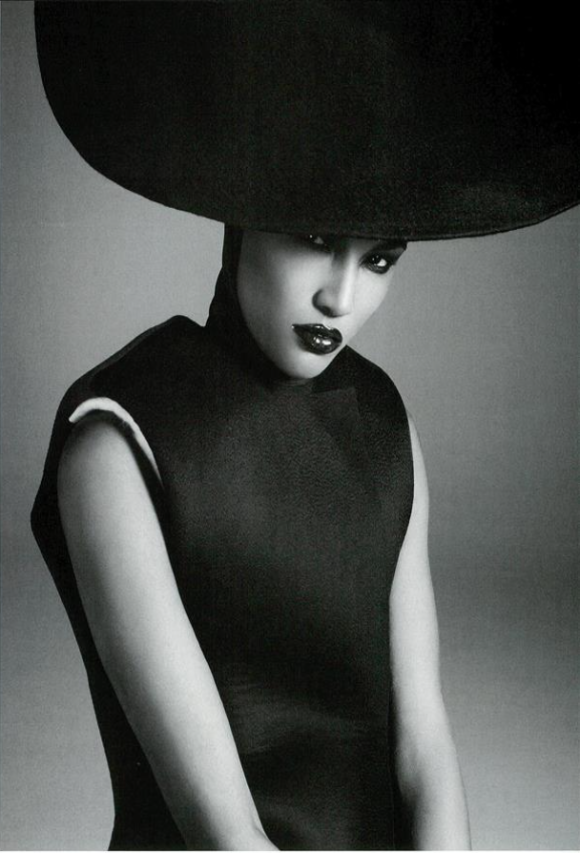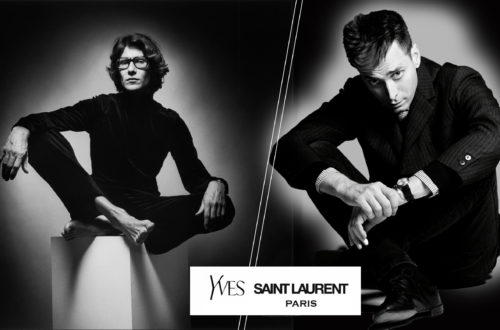“The most popular and the most convenient and the most elegant of all colours. And I say colour on purpose, because black may be sometimes just as striking as a colour.
It is the most slimming of all colours and, unless you have a bad complexion, it is one of the most flattering.
You can wear black at any time. You can wear it at any age. You may wear it for almost every occasion. A “little black frock” is essential to a woman’s wardrobe.
I could write a book about black…”
It was with this words that Christian Dior defined black in his Little dictionary of fashion. Essential. But has it always been like this? What lies in its darkness?

Photo by Steven Meisel, Vogue Italia, July 2008
It can be said that black found its fortune in the XVI-XVII centuries, that are considered the pinnacle of the colours’ popularity . Before the XVI century, fashion was a synonym for abundance, wealth and superficiality. At the end of the XV century, an opposite style, modest and measured, even if not less costly, placed itself side by side to it. According to the fashion psychologist John Carl Flügel, “ostentation-redundancy” and “modesty-surrender” are not opposite choices, but psychological struggles, characterizing every human being, between the need of being unique, of surprising, of standing out, and the one of being invisible, of blending into the crowd. In the XVI century, the kind of richness people wanted to show was the intellectual one. In order to underline this shift between a material richness and a spiritual one, people started wearing black because what was needed to be noticed were not the garments but the individuals that wore them. So wearing black meant not only to decide to wear something but also to show and declare the proper moral values. Therefore, it meant following the Horacian mediocritas, avoiding extremes in order to live a balanced life: avoid bright colours and excess in decoration, but also avoid monkish austerity. In 1500s, black was worn by the stars of portraits, by Protestants, by the Counter-Reformation and also by Royals: the Catholic Philip II of Spain wore black and, in the following 50 years, black established itself so much that in 1623 Philip IV decided that whoever was presented at the Spanish Court must wear black.

“Philip II”, by Tiziano, 1549-1550, oil painting on cavas, 103×82, Museo del Prado, Madrid, Spain.
In the same years, in Holland it became the colour of everyone: a black garment was worn in everyday life. The first work-clothes were born. And it was in this way that also a little girl who, in 1895, arrived in an antique convent of nuns in Aubazine, perceived black clothes. Her name was Gabrielle Chanel, or, as she is known worldwide, Coco. For nine years Coco was surrounded by black: smocks were black, tunics were black and also uniforms were black. This probably served as inspiration to realize her fashion revolution. In fact, up to the end of the World War I, black clothes were worn by people in mourning, a distinctive sign of sorrow. As Suzy Menkes – a British journalist and fashion critic – affirmed: “When the importance of associating a precise colour to mourning attenuated, at that point Black entered in the fashion arena. I don’t think that Black was a fashionable colour in history, it became fashionable when it ceased being the colour of mourning.” It was in 1926, when Chanel created the Little Black Dress that for the first time in hundreds years women wore black in order to be chic.

Portrait of Coco Chanel wearing a Little Black Dress, by Man Ray, 1935
The success of the Petit Robe Noir was something completely unexpected. According to Giusi Ferré – fashion and costume journalist – Chanel’s proposal of black and white was a countertrend: it followed an idea of order that, as it always is, was born from the absolute disorder, to go back to the essence. “Women think of all colours except the absence of colour. I have said that Black has it all. White too. Their beauty is absolute. It is the perfect harmony.” Coco said. In particular, disorder refers to the excessive richness and ostentation in vogue in those years, made of colourful fabrics and patterns, such as those realized by the so called King of fashion, Paul Poiret. In fact, Poiret was not able to accept the success of black and simplicity and, as Barbara Vinken – a fashion theorist – claimed, “Chanel has painted women’s body with the colour of ascesis, the colour of anti-fashion, the colour that refuses every ornamentation, every accessory.” According to Poiret, Chanel’s “women dressed in black resemble telegraph poles.” It is said Poiret and Chanel met once, strolling around the Parisienne streets, and he asked her: “Mademoiselle, why are you dressed in mourning?” She replied: “For you, Monsieur!”
David Downton – a fashion illustrator – claimed that “Black is a thrill, Black is the first sign you do, the black flash of ink on the white paper; it is the first thrill you experience.” Apart from illustration, in July 2008 black stood out in another field of fashion involving papers: the editorial one. In fact, in that date Vogue Italia published an issue dedicated to black beauty, an homage to coloured women who, with their style, have influence the aesthetic of our history. The entire issue was black: a black cover, black models, many black garments.
Black is elegant, black is powerful, black is tidy, black is always appropriate, black allows to show one’s personality. Maybe it is because of these reasons that many designers love it. Such as Yves Saint Laurent, who stated “I love Black because it affirms, designs and styles. A woman in a Black dress is a pencil stroke.”; or Karl Lagerfeld, who believes that “One is never overdressed or underdressed with a Little Black Dress.” And to those people wondering with a disapproving note why one should love wearing black, Yohji Yamamoto answers: “Black is modest and arrogant at the same time. Black is lazy and easy – but mysterious. But above all Black says this: “I don’t bother you – don’t bother me”.”

Photo by Steven Meisel, by Vogue Italia, July 2008
by Laura Gaudioso






